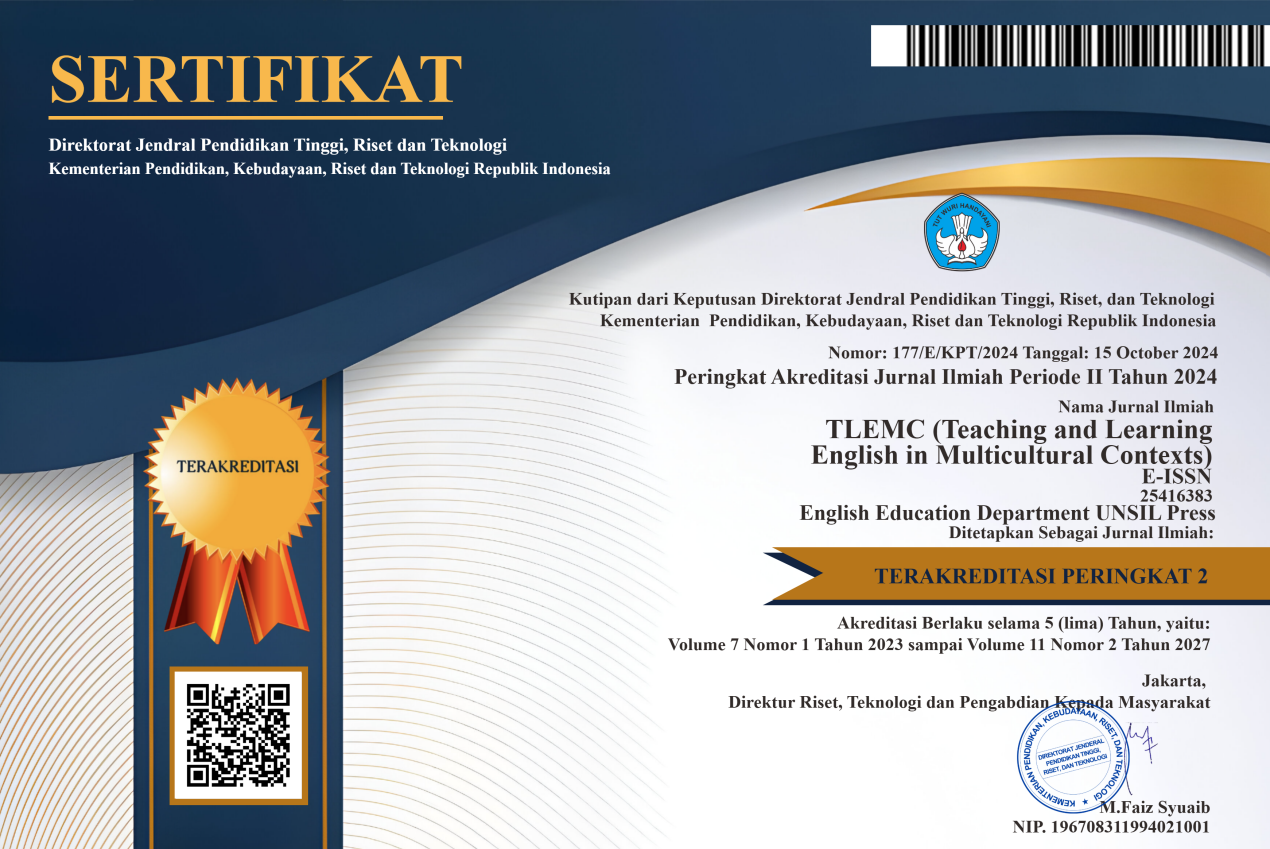Exploring Indonesian EFL learners’ extramural English activities
Abstract
Extramural English, also known as English exposure beyond the classroom, has become increasingly relevant for language learning, especially with technological advancements. To better understand how extramural English contributes to the English learning process in the Indonesian context, this study explores the extramural English activities of Indonesian EFL learners. A total of seventy-three university students majoring in English Language Education participated in a survey, which gathered data on their extramural English preferences and perceived benefits for language skills. The data were then thematically analyzed. The findings revealed that receptive-related activities were the most popular, with participants frequently engaging in listening to English songs (94.5%), watching music videos with English captions (82.2%), and watching films or TV series in English with Indonesian subtitles (76.7%). These activities were favored because they were enjoyable and provided opportunities for English development. Moreover, most participants perceived extramural English as beneficial for enhancing their knowledge of language items, language skills, and cultural understanding. The findings suggest that EFL teachers should incorporate more productive extramural English tasks to promote balanced skill development among learners.
Keywords: Extramural English, digital learning, English development
Full Text:
PDFReferences
Al-Shamsi, A., Al-Mekhlafi, A. M., Busaidi, S. Al, & Hilai, M. M. (2020). View of the effects of mobile learning on listening comprehension skills and attitudes of Omani EFL adult learners. International Journal of Learning, Teaching and Educational Research, 19(8), 16–39. https://doi.org/https://doi.org/10.26803/ijlter.19.8.2
Alshammri, A. F. (2023). Perceptions of Saudi EFL learners’ willingness to communicate in the extramural digital context. Theory and Practice in Language Studies, 13(8), 1920–1930. https://doi.org/10.17507/tpls.1308.07
Anggraini, M. P., Anugerahwati, M., Sari, R. N., Miranty, D., Kurniasih, & Iswahyuni. (2022). The ICT use of informal digital learning in enhancing EFL university students’ english performance. Call-Ej, 23(3), 94–114.
Avello, M., Camacho-Miñano, M. del M., Urquia-Grande, E., & del Campo, C. (2019). “Do you use english in your daily life?” Undergraduate students’ perceptions of their extramural use of English. Journal of Teaching in International Business, 30(1), 77–94. https://doi.org/10.1080/08975930.2019.1627978
Coşkun, A., & Mutlu, H. T. (2017). Investigating high school students’ use of extramural English: A scale development study. ERIC: Online Submission, 6, 571–590.
Creswell, J.W. (2011). Educational research: planning, conducting, and evaluating quantitative and qualitative research (Fourth). Pearson.
Emeral, E., & Farid, R. N. (2024). Narrative inquiry: An advanced user’s strategy to speak fluently in English. Premise: Journal of English Education and Applied Linguistics, 13(2), 490–506. https://doi.org/10.24127/pj.v13i2.9071
Gass, S. M. (2015). Comprehensible input and output in classroom interaction. The Handbook of Classroom Discourse and Interaction, 182–197. https://doi.org/10.1002/9781118531242.ch11
Gass, S., & Mackey, A. (2006). Input, interaction, and output. AILA Review, 19, 3–17. https://doi.org/10.4324/9781410604651-14
Jensen, S. H. (2017). Gaming as an English language learning resource among young children in Denmark. CALICO Journal, 34(1), 1–19. https://doi.org/10.1558/cj.29519
Krashen, S. D. (1982). Principles and practice in second language acquisition. Pergamon Press Inc.
Krashen, S. (2013). Second language acquisition (Theory, applications, and some conjectures). Mexico: Cambridge University Press
Lee, J. S., & Drajati, N. A. (2019). Affective variables and informal digital learning of English: Keys to willingness to communicate in a second language. Australasian Journal of Educational Technology, 35(5), 168–182. https://doi.org/10.14742/ajet.5177
Lee, J. S., Lee, K., & Chen Hsieh, J. (2022). Understanding willingness to communicate in L2 between Korean and Taiwanese students. Language Teaching Research, 26(3), 455–476. https://doi.org/10.1177/1362168819890825
Lee, J. S., & Sylvén, L. K. (2021). The role of Informal digital learning of English in Korean and Swedish EFL learners’ communication behaviour. British Journal of Educational Technology, 52(3), 1279–1296. https://doi.org/10.1111/bjet.13082
Lee, M., & Révész, A. (2020). Promoting grammatical development through captions and textual enhancement in multimodal input-based tasks. Studies in Second Language Acquisition, 42(3), 625–651. https://doi.org/10.1017/S0272263120000108
Leona, N. L., van Koert, M. J. H., van der Molen, M. W., Rispens, J. E., Tijms, J., & Snellings, P. (2021). Explaining individual differences in young English language learners’ vocabulary knowledge: The role of extramural English exposure and motivation. System, 96, 102402. https://doi.org/10.1016/j.system.2020.102402
Lodico, M. G., Spaulding, D. T., & Voegtle, K. H. (2010). Methods in educational research (From theory to practice). In Jossey-Bass. https://doi.org/10.2105/ajph.2.12.981
Lyrigkou, C. (2019). Not to be overlooked: agency in informal language contact. Innovation in Language Learning and Teaching, 13(3), 237–252. https://doi.org/10.1080/17501229.2018.1433182
Macintyre, P. D., Dornyei, Z., Clément, R., & Noels, K. A. (1998). Conceptualizing willingness to communicate in a L2: A situational model of L2 confidence and affiliation. Modern Language Journal, 82(4), 545–562. https://doi.org/10.1111/j.1540-4781.1998.tb05543.x
Malyndra, D., Drajati, N. A., & Asrori, M. (2020). Students’ willingness to communicate in extramural English activities in digital EFL context: A Narrative Inquiry. Edulangue, 3(1), 49–68. https://doi.org/10.20414/edulangue.v3i1.2093
Muñoz, C., Pujadas, G., & Pattemore, A. (2023). Audio-visual input for learning L2 vocabulary and grammatical constructions. Second Language Research, 39(1), 13–37. https://doi.org/10.1177/02676583211015797
Newton, J., & Nation, I. S. . (2014). Teaching ESL. http://www.atesolnsw.org/Noticeboard/Teaching-ESL
Noels, K. A., Pelletier, L. G., Clément, R., & Vallerand, R. J. (2000). Why are you learning a second language? Motivational orientations and self-determination theory. Language Learning, 50(1), 57–85. https://doi.org/10.1111/0023-8333.00111
Pekrun, R. (2020). Commentary: Self-report is indispensable to assess students’ learning. Frontline Learning Research, 8(3), 185–193. https://doi.org/10.14786/flr.v8i3.637
Peters, E., & Webb, S. (2018). Incidental vocabulary acquisiton through viewing L2 television and factors that affect learning. Studies in Second Language Acquisition, 40(3), 551–577. https://doi.org/10.1017/S0272263117000407
Richards, J. C. (2015). Key issues in language teaching. In Cambridge Univeristy Press. https://doi.org/10.1017/9781009024600
Salsabila, W., Irianti, L., & Thoyyibah, L. (2021). The effectiveness of georgiana’s podcast on spotify to improve students’ listening skills. TLEMC (Teaching & Learning English in Multicultural Contexts), 5(2), 156–163. http://jurnal.unsil.ac.id/index.php/tlemc/index
Schurz, A., Coumel, M., & Hüttner, J. (2022). Accuracy and fluency teaching and the role of extramural English: A Tale of Three Countries. Languages, 7(1), 1–15. https://doi.org/10.3390/languages7010035
Sundqvist, P. (2019). Commercial-off-the-shelf games in the digital wild and L2 learner vocabulary. Language Learning and Technology, 23(1), 87–113. https://doi.org/10.125/44674
Sundqvist, P., & Sylvén, L. K. (2016). Extramural English in teaching and learning. In Extramural English in Teaching and Learning. https://doi.org/10.1057/978-1-137-46048-6
Sundqvist, P., & Uztosun, M. S. (2023). Extramural English in Scandinavia and Asia: Scale development, learner engagement, and perceived speaking ability. TESOL Quarterly, 0(0), 1–28. https://doi.org/10.1002/tesq.3296
Sylvén, K. L., & Sundqvist, P. (2012). Gaming as extramural English L2 learning and L2 proficiency among young learners. ReCALL, 24(3), 302–321. https://doi.org/10.1017/S095834401200016X
Wahidah, S. S., Sri, M., & Silvani, D. (2024). Unveiling pedagogical potential: Indonesian higher education students’ perception on leveraging BTS’ English songs for vocabulary enhancement. TLEMC (Teaching and Learning English in Multicultural Contexts), 8(1), 24–38. https://doi.org/10.37058/tlemc.v8i1.10489
Warnby, M. (2022). Receptive academic vocabulary knowledge and extramural English involvement – is there a correlation? ITL - International Journal of Applied Linguistics, 173(1), 120–152. https://doi.org/10.1075/itl.21021.war
Zhang, R., Zou, D., Cheng, G., Xie, H., Wang, F. L., & Au, O. T. S. (2021). Target languages, types of activities, engagement, and effectiveness of extramural language learning. PLoS ONE, 16(6 June), 1–16. https://doi.org/10.1371/journal.pone.0253431
Zunuaris, F., & Zainil, Y. (2023). How do efl students acquire input outside the classroom? (Issue Icoelt 2022). Atlantis Press SARL. https://doi.org/10.2991/978-2-38476-166-1_23
DOI: https://doi.org/10.37058/tlemc.v9i1.13858
Refbacks
- There are currently no refbacks.
INDEXED BY:
This work is licensed under a Creative Commons Attribution-NonCommercial-ShareAlike 4.0 International License.
![]()
TLEMC (Teaching and Learning English in Multicultural Contexts)
Program Studi Pendidikan Bahasa Inggris
Fakultas Keguruan dan Ilmu Pendidikan
Universitas Siliwangi
Jl. Siliwangi No. 24 Kota Tasikmalaya - 46115
email: tlemc@unsil.ac.id





